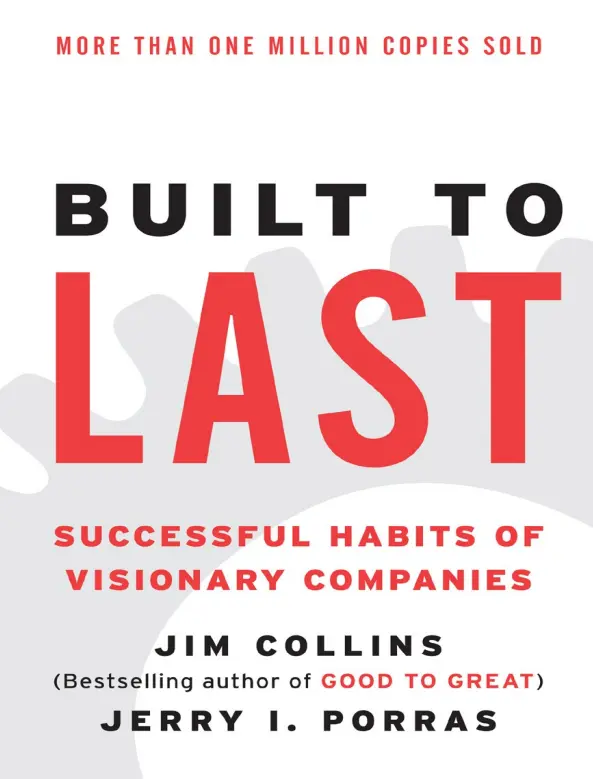
Built to Last reveals the timeless principles behind the world’s most enduring companies. Through decades of research, Jim Collins and Jerry Porras show that lasting success comes not from charismatic leaders or lucky breaks, but from strong core values, bold vision, and disciplined execution. This book teaches how to build a company that thrives across generations, not just survives.
Built to Last is a landmark study that explores what makes some companies truly great over the long term , not just successful for a season.
Written by Jim Collins , a renowned researcher and author in business strategy, and Jerry I. Porras , a professor at Stanford University, this book analyzes 18 visionary companies —such as Hewlett-Packard, Johnson & Johnson, Procter & Gamble, Sony, and Walt Disney—alongside comparison companies with similar starting points but less enduring success.
The central question they ask:
“What allows certain companies to endure and thrive across decades—even centuries—while others fade away?”
Through six years of research and analysis, Collins and Porras uncover timeless principles that separate visionary companies from merely good ones .
Unlike many business books that focus on short-term performance or charismatic CEOs, Built to Last shows that the most enduring companies share a set of deep-rooted values and habits that guide them through generations.
Key themes include:
Key Insight: Great companies don’t chase trends—they build foundations strong enough to survive any trend.
Collins and Porras carefully selected 18 visionary companies and matched them with comparison companies that had similar origins, industries, and opportunities—but did not achieve the same lasting greatness.
Some surprising findings:
Important Lesson: Enduring success comes from who you are , not just what you do.
One of the most powerful ideas in the book is the concept of core ideology , which has two components:
These remain constant, even as strategies, products, and leaders change.
Example: Walt Disney’s core purpose was not animation—it was “to create happiness for people.”
Key Insight: Visionary companies stay true to their core ideology while being flexible in how they express it.
A paradoxical principle emerges throughout the book:
“Preserve the Core / Stimulate Progress”
This means:
Visionary companies balance stability and change better than others. They don’t abandon tradition—they reinvent within the framework of their identity.
Important Lesson: Innovation doesn’t mean abandoning who you are—it means expressing your values in new ways.
Another major theme is the difference between “time telling” and clock building.”
Many founders are brilliant time tellers—they have great ideas. But visionary companies are built by clock builders —people who create organizations that continue to produce great results long after they’re gone.
Example: Sam Walton didn’t just build Walmart—he built a system that could scale and adapt globally.
Key Insight: True leadership is about building something that outlives you .
Two more key concepts introduced in the book:
Companies that instill strong, shared values and high standards tend to attract passionate employees who believe deeply in the mission. This isn’t cult-like in the negative sense, but rather a deep commitment to purpose.
These are bold, long-term objectives that energize and unify an organization. BHAGs aren’t about profit—they’re about making a mark on the world .
Example: NASA’s BHAG in the 1960s: “Put a man on the moon before the end of the decade.”
Important Lesson: Visionary companies inspire loyalty and action through meaning and challenge , not just incentives.
Throughout the book, Collins and Porras draw from rich case studies of iconic companies:
These examples show that visionary companies don’t follow formulas—they build cultures and systems that foster greatness .
While Built to Last was published nearly 30 years ago, its lessons remain highly relevant today. Whether you’re leading a startup, a family business, or a Fortune 500 company, these principles apply:
Key Insight: Enduring greatness is not about charisma or luck—it’s about consistency, clarity, and courage.
Built to Last challenges the myth that only charismatic founders can build great companies. Instead, it shows that lasting success comes from deliberate choices —choices about values, culture, leadership, and long-term vision.
As Collins and Porras write:
“Greatness is a matter of conscious choice—and discipline.”
Whether you’re an entrepreneur, manager, or student of business, this book offers a blueprint for building something that lasts.